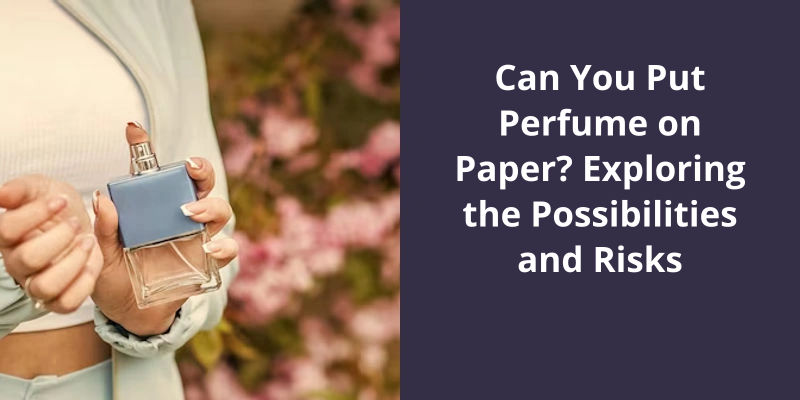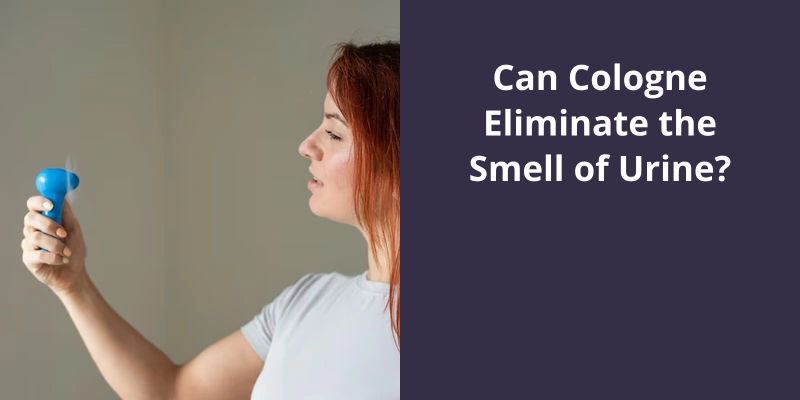Yes, perfume can indeed be applied to paper. This practice is quite common among perfume enthusiasts who want to capture the scent without applying it directly to the skin. In fact, perfume shops often allow customers to spray different fragrances onto small pieces of cardstock or blotting paper for a no-contact test. While it won’t completely replicate the scent’s interaction with your skin, it does give an accurate general impression. However, bear in mind that perfume can potentially stain paper, particularly if it is colored. Therefore, care should be taken when spraying perfume on important or valuable documents.

Can I Spray Perfume on Paper?
Many perfume enthusiasts who’re passionate about the art of perfumery find themselves inquisitive about the extent to which perfumes can be tested or experimented with. Among these questions is the possibility of spraying perfumes on paper. While it isn’t uncommon to test a perfumes scent by spraying it on your skin, it’s understandable that some people may prefer not to do so due to allergies or fragrance sensitivities.
To get started, simply choose the desired piece of paper and lay it on top of a newspaper or any other protective surface. Next, you can proceed to open your favorite perfume and carefully spray the paper until it’s damp with the fragrance. However, it’s important to note that you shouldnt spray the paper excessively as this can cause it to wrinkle and become ruined.
After spraying the paper with the perfume, it’s essential to let it dry to avoid ruining the smell or the paper itself. It’s important to be patient while the paper dries to allow the scent to fully settle and avoid smudging or staining clothes or other surfaces when handling the paper.
The use of perfume test paper has become an essential tool for perfume researchers and enthusiasts. As a versatile material, it offers numerous benefits that make it an ideal choice for testing fragrances. In this article, we delve into the reasons behind why perfume is sprayed on paper and how it enhances our understanding of the olfactory world.
Why Are Perfume Sprayed on Paper?
Perfume test paper or fragrance blotter is an essential tool for anyone involved in the perfume industry. It’s an absorbent paper used for testing fragrances and is sprayed with perfume to analyse the scent. The way it reacts to the fragrance can help researchers and perfume makers understand it’s composition, as well as determine how it will smell on skin.
The use of test paper is considered to be a more accurate method of evaluating perfumes, compared to spraying it on the skin. This is because the skin can alter the scent and mask certain notes, whereas the paper absorbs the fragrance without any bias. It also allows testers to smell multiple perfumes at once, without having to wait for them to dry down on the skin.
The test paper itself is made from a thick and sturdy absorbent material, which is designed to resist tearing and maximize absorbency. This helps to ensure that each sample sprayed on the paper is consistent and repeatable. It also allows for precise measurements of the fragrance, as the amount sprayed can be controlled and measured accurately.
Moreover, the papers texture plays a crucial role in how well it can absorb the scent. If the paper is too smooth or thin, it might not capture the full range of fragrant molecules as effectively.
It’s absorbent and durable properties make it an ideal material for capturing the full spectrum of fragrant molecules in perfumes. As such, it remains one of the most critical components of the perfume-making process, used to develop and refine new fragrances that capture the essence of beauty and elegance.
The Role of Fragrance Blotting Paper in Sensory Evaluation and Quality Control of Perfumes
- Provides a controlled and standardized scent release.
- Allows for the assessment of individual fragrance notes.
- Helps to identify any off-notes or unpleasant odors.
- Enables accurate comparison and evaluation of different fragrance formulations.
- Assists in quality control by detecting changes or inconsistencies in scent over time.
- Can be used in consumer testing to evaluate how a fragrance is perceived and received by the target audience.
Source: Spraying on skin vs on paper/tissue = different smells?
Using paper to test fragrances has been a long-standing practice in the perfume industry. While some may question whether the perfume will stay on the paper, it largely depends on the quality of the paper and the perfume itself. In fact, the type of paper used is crucial to accurately evaluate the scent and it’s longevity.
Will Perfume Stay on Paper?
If the perfume is high quality, it will have a better chance of staying on the paper for longer periods of time. The concentration of the perfume and the specific notes of the fragrance can also affect it’s staying power on paper. Some fragrances may dissipate quickly while others may linger for hours.
Higher temperatures may cause the fragrance to evaporate more quickly, while higher humidity levels may cause the paper to become damp and reduce it’s ability to hold onto the fragrance. As such, it’s important to store paper fragrance strips or blotters in a cool, dry place.
While paper can hold onto fragrances for some time, it won’t retain them indefinitely. After a few hours or a day, the scent may start to fade and eventually disappear altogether. Therefore, using a new strip for each fragrance you want to test is best practice.
How to Create Your Own Custom Fragrance Using Paper Fragrance Strips
- Gather your fragrance oils and materials
- Prepare your work area, making sure it’s clean and free of any strong scents
- Cut your paper fragrance strips into small rectangles
- Drop a small amount of each fragrance oil onto a separate strip
- Blot each fragrance strip onto a piece of white cardstock to get an idea of how the fragrance will smell when dry
- Combine the fragrance strips as desired to create a custom fragrance blend
- Once you’ve created your desired fragrance, let it sit for a few hours to fully develop before using or testing
- Store your custom fragrance blend in an airtight container to preserve the scent
It’s understandable to want to send a loved one a nice fragrance through the mail. However, it’s important to be aware of the regulations surrounding the shipment of perfumes and fragrances. Not only could you risk having your package confiscated or returned, but you could also face legal consequences for attempting to ship prohibited items. In this article, we’ll explore the do’s and don’ts of mailing fragrances and offer some tips for safe and legal shipping.
Can You Spray Perfume on Mail?
When it comes to sending perfume through the mail, there are some rules and regulations that must be followed in order to ensure that the package arrives safely and legally. Generally, it’s possible to ship perfume within the United States using ground transportation, which ensures that the package is less likely to be damaged or exposed to extreme temperatures during transit.
However, if you’re planning to ship perfume internationally or by air, you may run into some difficulties. This is because many countries and airlines have restrictions on shipping products that contain alcohol, which is a common ingredient in many types of perfume.
One option for shipping perfume by mail is to use a carrier that specializes in transporting fragrances and other liquid products.
Another thing to keep in mind when shipping perfume by mail is that it’s important to properly package and label your package to ensure that it’s handled correctly by postal workers and other shipping personnel. This may include using special packaging materials, such as bubble wrap or tamper-evident seals, as well as including clear instructions and warnings on the outside of the package to alert handlers to the contents of the package.
How to Properly Package Perfume for Mailing
- Use a sturdy cardboard mailing box that’s slightly larger than the perfume bottle.
- Wrap the perfume bottle in bubble wrap and secure it with tape.
- Place the wrapped bottle in a small ziplock bag to prevent leakage.
- Fill any empty space in the box with packing peanuts or bubble wrap to prevent the bottle from shifting during transit.
- Seal the box with packing tape and label it as fragile.
- Consider adding extra insurance to the package for added protection.
As the tradition of sending scented letters continued to be popular, it became a form of art – with various scents mixed together and added to the ink or paper. This led to the rise of scented stationery and perfumed envelopes. Let’s take a closer look into the history of scented letters and why people spray perfume on them.
Why Did People Spray Perfume on Letters?
The practice of spritzing perfume onto letters has it’s roots in ancient times. In the early days of letter writing, people would use natural fragrances such as flowers and herbs to scent their correspondence. This was not just for aesthetic purposes, but also to convey a particular mood or emotion. For instance, lavender was often used to evoke a sense of calmness and relaxation, while rose petals indicated passion and love.
The custom of perfuming letters continued to be popular throughout history, particularly among the upper classes. In the Victorian era, for example, genteel ladies often used scent to mask unpleasant odors, such as the smell of ink or moldy paper. They’d apply a few drops of perfume onto their correspondence using a small brush or sprayer, before sealing the letter with wax.
Flash forward a few decades later to the First World War, when writing to loved ones was incredibly popular. To make the letter more personal, many women would spritz on their signature perfume to remind their soldier of being back home in their arms. The scent of their loved ones perfume would provide comfort and solace in the midst of war and separation.
Today, the practice of perfuming letters isn’t as common as it once was, given the convenience of electronic communication. However, it’s still used by some to add a touch of romance or nostalgia to their correspondence. And while we may never know exactly why people started scenting their letters, we can appreciate the beauty and sentimentality of this ancient tradition.
-Specific Examples of Perfumes and Their Meanings Throughout History
This article explores the significance of different perfumes throughout history, including notable examples and their cultural and symbolic meanings.
Conclusion
A high-quality kraft or cotton paper with exceptional absorbent properties is necessary to create a reliable smelling strip or blotter. It’s crucial to select an odourless paper to avoid any interference with the fragrance being tested.





